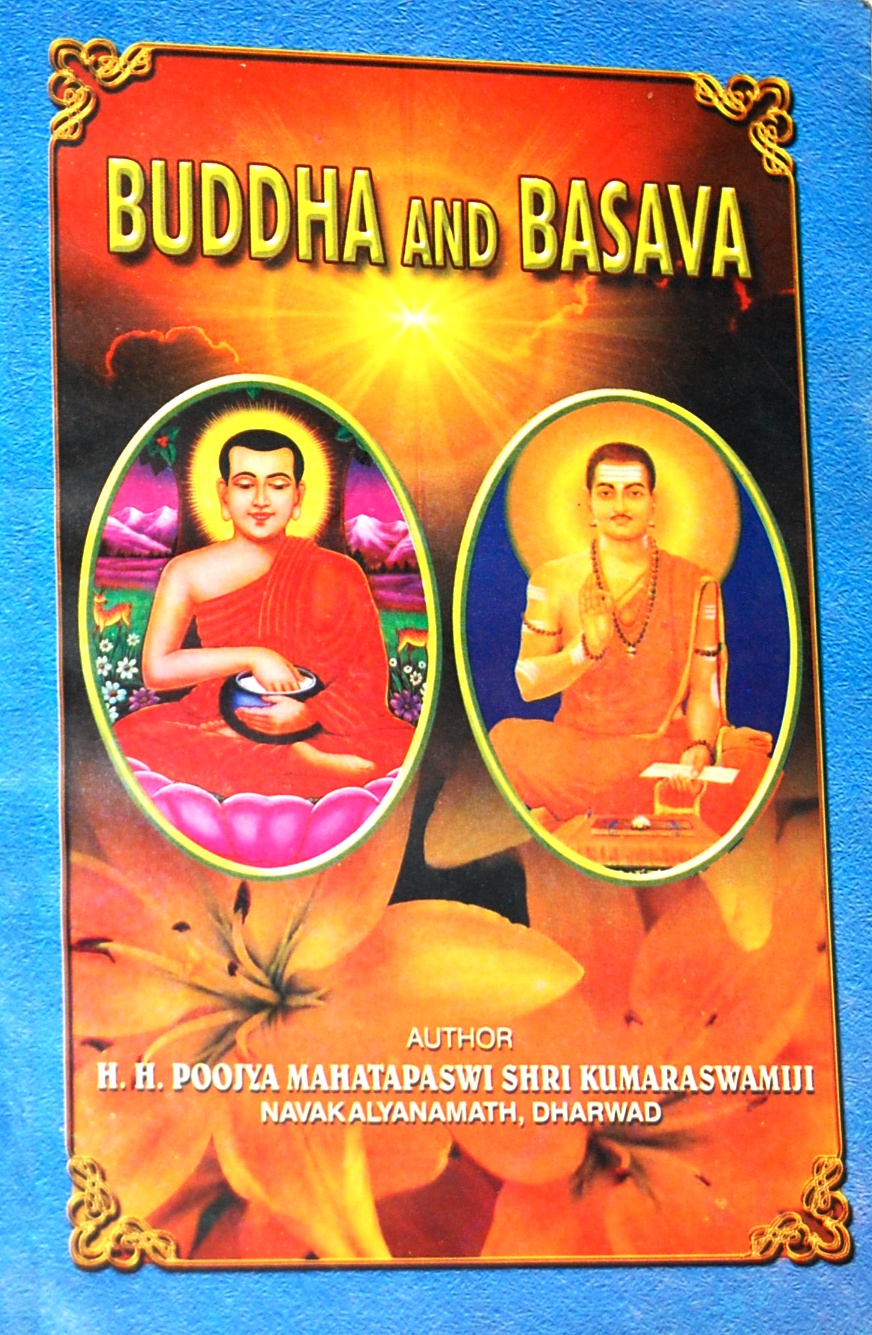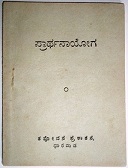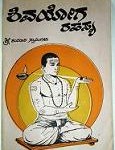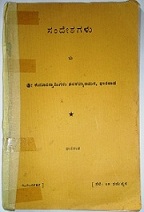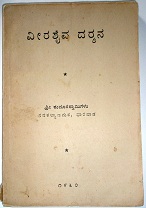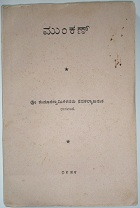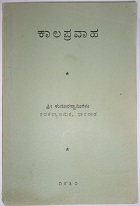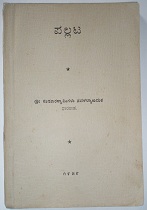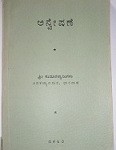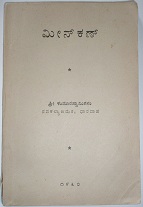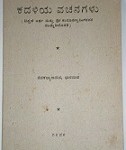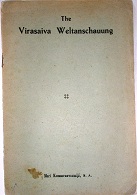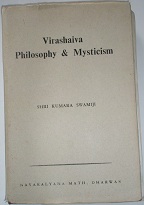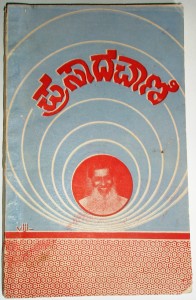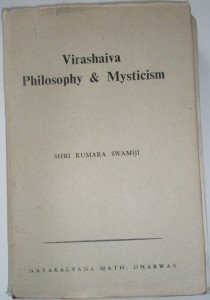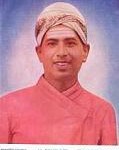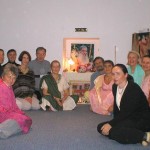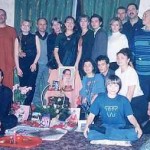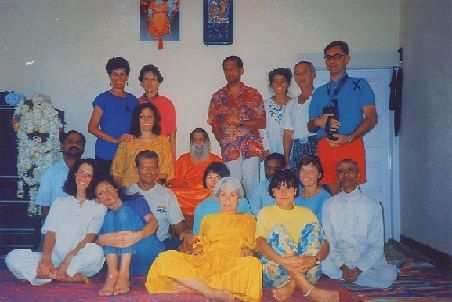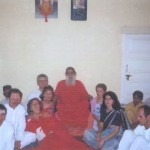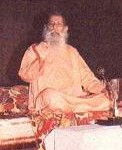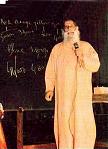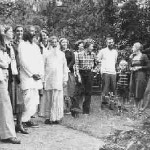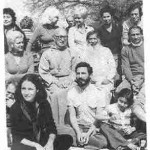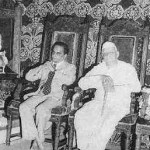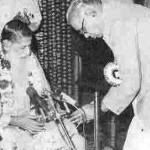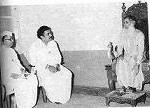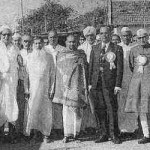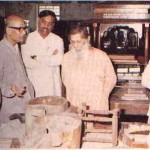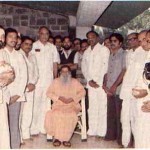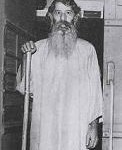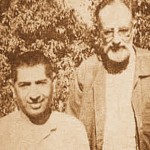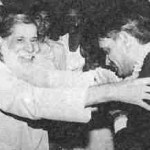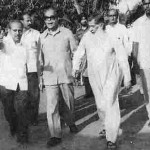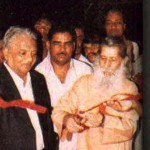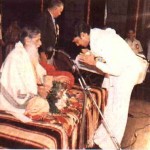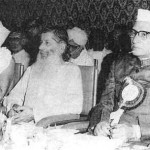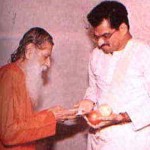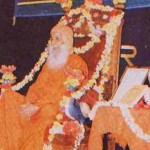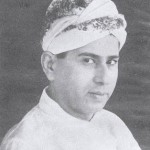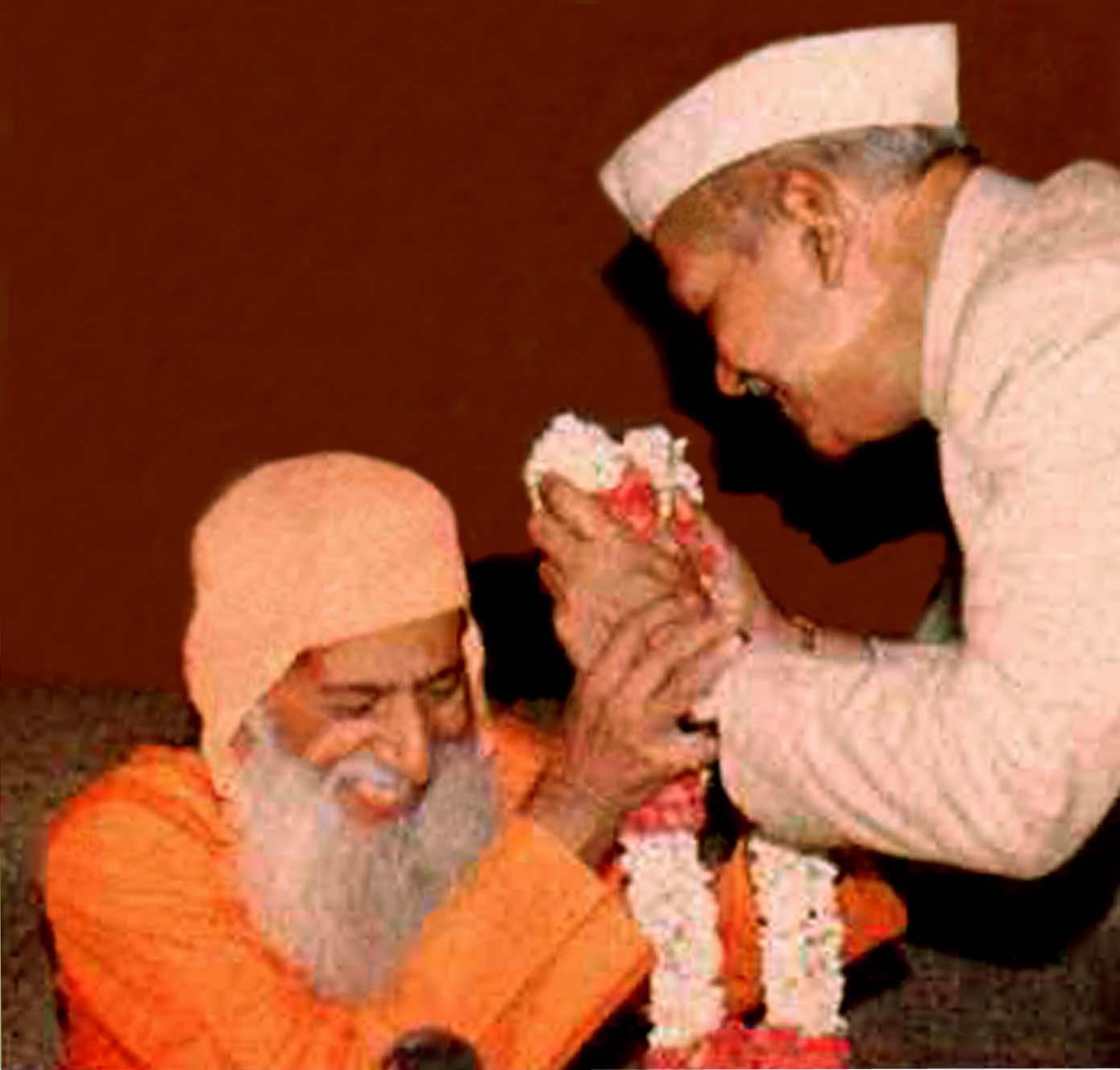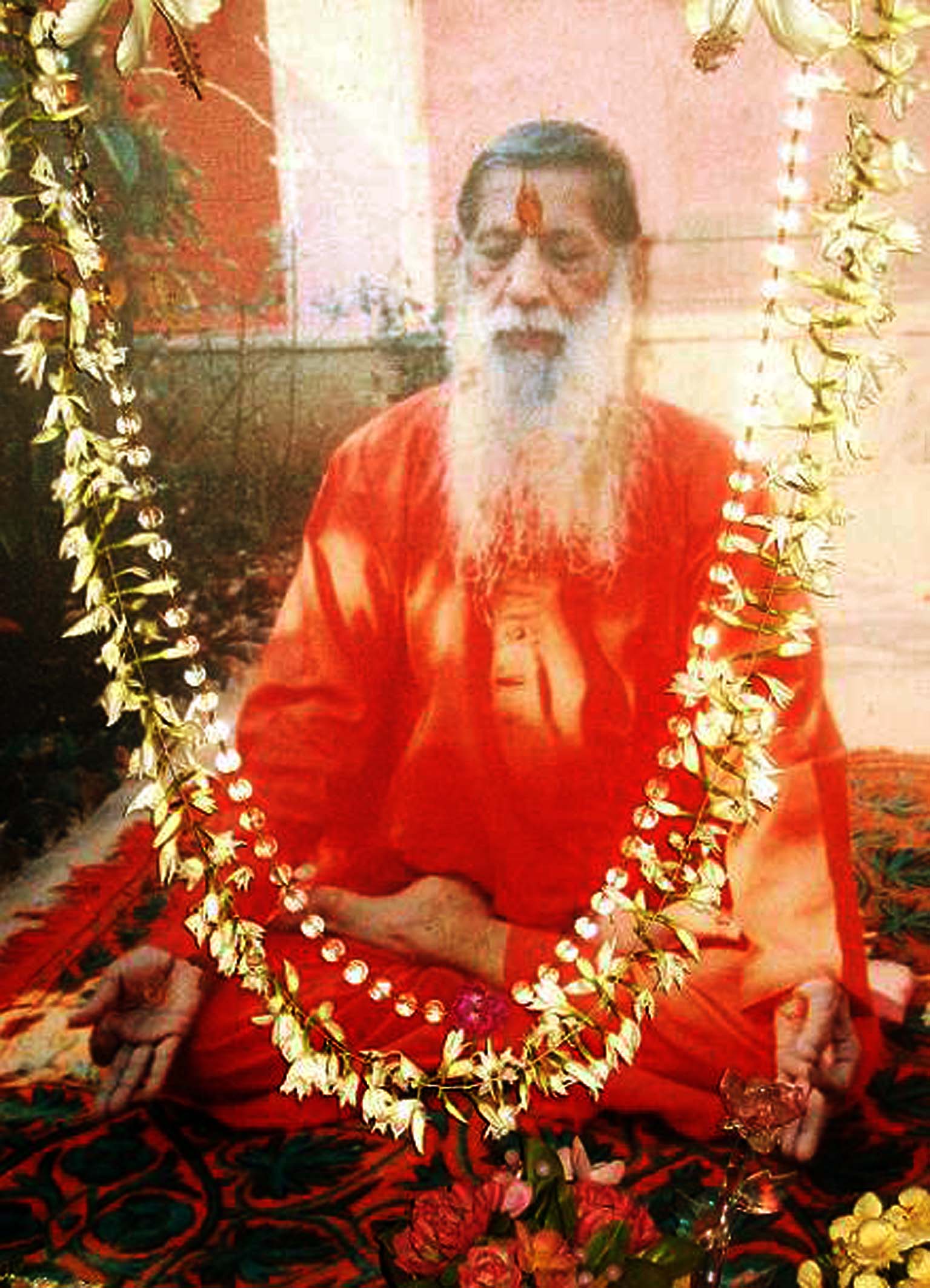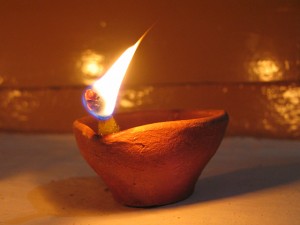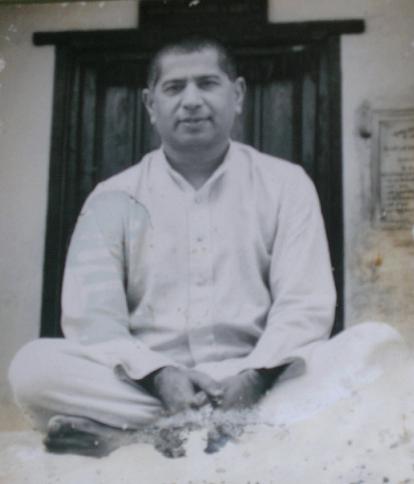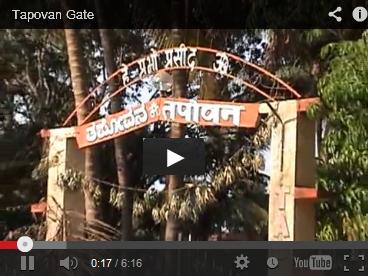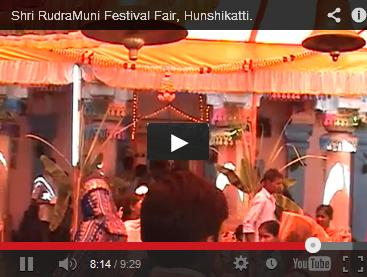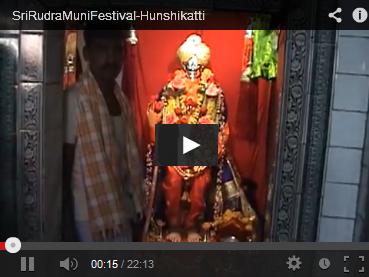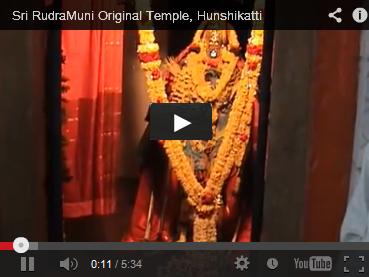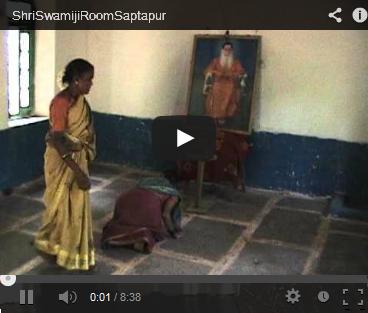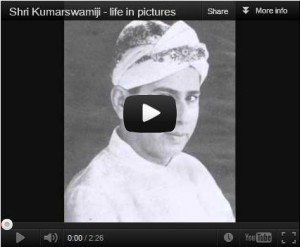The Veerashaiva system acknowledges Naiyayika’s cosmic principles which it terms Astavarna. Astavarna means eight fold vestures and the interpretation of Astavarna is more psychological; for Atavarna is conceived as the outcome of Para-prakriti or Chit-shakti which exists in Shiva by the relation of identity. Chit-shakti diffuses itself into Astavarna, the eight fold vestures which serve as divine garments to Shiva. All speculation has tacitly figured man as a clothed animal; man is by nature a naked animal, but only with a purpose he covers himself in clothes. That God clothes himself in divine garments proves that creation has a divine purpose. Guru, Linga, Janagama or Ishta, Prana, Bhava, Mantra, Vibhuti, Rudraksh, Padodaka and Prasada are the eight Avaranas or vestures also called as Ashta – avarana.
We are pious, we are pious, they cry !
I am shocked to see Oh! Guheshvara !
The self-styled devotees worship the Linga
Without clearing the taint
Of the earth and water,
Of fire, air and sky,
Of sun and moon
And self.
— Allama Prabhu
In the Vachana (sayings) of the Veerashaiva saints we invariably come across the word Pinda. Pinda-sthala forms the first stage of the pilgrim’s progress. Pinda means Prakriti. Pinda is not mere body but it is body with the individual self. Hence the human soul together with body is known as Adhi-pinda or Apara-Prakriti. Similarly, the whole cosmos serves, as it were, a body up to the Absolute Spirit or Shiva. This cosmic body together with the Supreme Spirit is known as Anadhi-pinda or Para-prakriti. Between the Adhi-pinda and Anadhi-pinda there exists an organic relation. Pinda itself means an organized whole, a living unity of many parts. Since the whole exists in every part, the one pervades, enlivens and harmonizes each of the parts, though the constituent parts may have their distinctive characteristics. All our concepts of concrete realities in all the planes of thought and knowledge involve the idea of unity in diversity. The whole cosmos is conceived as one organism. Samashti-pinda – comprising innumerable orders of Vyashti-pindas.
In Shaivism Shiva is described as Enmai, that is eight-bodied, it is strange enough that the word Enmai is found in Mohenjo Daro inscriptions. This fact alone proves the historical priority of Shaivism to some other faiths. Later on, the word Enmai was translated into Sanskrit as Ashta-tanu-murti – the eight bodied figure. Kalidasa in the opening verse of his Shakuntala delineates Shiva as one having eight bodies. What are those eight bodies? They are earth, water, fire, air, ether, sun, moon and soul. Sometimes the substitutes for sun and moon are space and time. The description of the Enami has been made from the cosmological standpoint. Shiva is immanent as well as transcendent; He is Vishvarupa and Vishvadhika. Almost every Shaiva saint has sung the praise of both these aspects of God. Shiva appears in the form of the universe, but the universe does not exhaust his nature. The concept of Astamurti or Enmai brings out the aspect of God’s immanence. Manikkavachakara sings:
“Earth, water, fire, air, sky, the sun and the moon,
The sentient man – these eight forms He pervades.”
In the dim distant past of the Chalcolithic age the treatment of those cosmic principles is not clear and emphatic or it may be shrouded in occult language. However, the clue to the treatment can be had from the Nyaya and Vaisheshika systems, for Gautam and Kanada – the founders of these two systems are reputed to be the worshippers of Shiva. It is likely that in the Shaiva tradition of theology may have found its exposition as regards Enmai. Gautama enumerates nine substances and they are as follows: earth, water, light, air, ether, time, space, soul and mind. Barring the last substance namely mind, the remaining eight substances correspond to the eight cosmic principles enunciated by Shaivism. Earth, water, fire or light, air and ether are the five elements which are regarded as faces of Shiva. They are Aghora, Sadyojata, Vamadeva, Tatpursha and Ishana. The meanings of these names are the terrible, suddenly born, the Deva of the Vama path. “That One” and the Lord. This fact seems to conclude that the names of the five elements came down to the Naiyayikas from a very ancient source and that had no choice but to recognize them if they wanted to preserve their orthodoxy. They only assigned to each element such place and functions as were fit to harmonize with their own physical theory of the universe.
The Veerashaiva system acknowledges their cosmic principles which it terms Astavarna. Astavarna means eight fold vestures and the interpretation of Astavarna is more psychological; for Astavarna is conceived as the outcome of Para-prakriti or Chit-shakti which exists in Shiva by the relation of identity. Chit-shakti diffuses itself into Astavarna, the eight fold vestures which serve as divine garments to Shiva. All speculation has tacitly figured man as a clothed animal; man is by nature a naked animal, but only with a purpose he covers himself in clothes. That God clothes himself in divine garments proves that creation has a divine purpose. Guru, Linga, Janagama or Ishta, Prana, Bhava, Mantra, Vibhuti, Rudraksh, Padodaka and Prasada are the eight Avaranas or vestures. Ishta, Prana, Bhava are the three levels of the Divine – the individual, universal and transcendental. The Divine in his Para-prakriti is the energy at the basis of various sensory relations of which the five elements of matter are the physical medium. The five elemental conditions of matter are the quantitative, while the five Tanmatras are the qualitative. Matter and material medium are themselves derivative powers, and at bottom are only concrete ways or conditions in which the workings of nature manifest themselves to the sensory consciousness of the Jiva or the personal self. The impersonal self of all things, the calm continent of the Cosmos is the universal level of the Divine. It is the force of Spirit, it is the light of its consciousness and the power of its energy in things revealed in a pure original sign that is the eternal seed. “The Divine casts this eternal seed into the supra-mental vastness, from which all are born into phenomenal existence.” The third level of the Divine is the transcendent reality, the supra-cosmic origin which contains both the personal self and the impersonal self, but conditioned and limited by neither of them.
Mantra is the name of the Divine or Shiva, the name is either Panchakshara, five-lettered or Shadakshara – six lettered. The efficacy of the name has been recognized by the mystics of all lands. The mystic says that he is indeed indescribable. “The cloud of unknowing” cries thus: “Fasten this word (name) to thy heart, so that is never goeth thence for thing that befalleth. This word shall be thy shield and thy spear whether thou rideth on peace or war. With this word thou shalt beat on this cloud and this darkness above thee. With this word thou shalt smite down all manner of thought under the cloud of forgetting.”
Vibhuti is the spiritual illumination of Shiva; while Rudrakshi is his penetrating vision. Padodaka is his ecstatic joy and Prasada is his divine grace. The three levels of consciousness of Shiva and his five modes of spiritual living together constitute the eight cosmic principles. The Veerashaiva system transforms these abstract principles into the concrete objects for the purpose of religious practice. Hence the importance of Astavarana from the practical point of view.
The Enmai which the Shaiva system conceives as the eight-fold body of Shiva, is for the Veerashaiva system apara-prakriti the lower nature which is eight-fold. The first product of evolution from Prakriti is Mahat or intellect, the second is Ahamakara or ego and the third is mind or Manas. The five elements namely, earth, water, fire, air, ether together with reason, ego and mind constitute the eight-fold nature. In Veerashaivism, Prakriti is considered to be Ashuddha or impure and all the evolutes of Prakriti are bound to be impure. But they have to be purged of their impurity which is known as Purvashraya. How is this to be effected? By the touch of Para-prakriti or spiritual nature, which becomes the Jiva and by which this world is upheld. The Sankhya does not admit this higher nature; it stops at the lower nature and because it stops there, it has to set up an unbridgeable gulf between the soul and nature. The eight fold evolutes of Prakriti should then be turned into eligible moulds of Astavarna which are the outcome of higher nature.
The Purvashraya or the contacted impurity of the earth element, the quality of which is Gandha or smell, should be purged by prasada or consecrated food; that of water element the quality of which is Rasa or taste, by Padodaka or consecrated water; that of fire element the quality of which is Rupa or form, by Rudrakashi, which is symbolical of right angle of vision; that of air element the quality of which is Sparsha or touch, by Vibhuti which is symbolical of inner light; that of either element the quality of which is Shabda or sound, by Mantra which symbolizes power. The sun and moon are symbolical of intellect and mind. The impurity of intellect which is the sense of understanding should be removed by Guru, the preceptor, that of mind with its sense organs by Linga, the principle, and that of ego with its sense of elation by Jangama, the person.
According to Prabhu, he is the real Bhakta who has achieved this transformation of the lower nature into the higher one through the instrumentality of Ashtavarna.
Guru: Veerashaivism in following the fine metaphysical vision of the One Being as the background and support of life conceives man as potentially divine. Man is reflection of God. He is the spirit in flesh, struggling to give concrete expression to divinity in its unfoldment through the individual, family and society. Since man is potentially divine, Veerashaivism refuses to accept the original sin of man; Man is not emergence of nature; he is a descent of the divinity on earth. The Divine is all but its immanence in spirit is evident in man. Man is not a sinner by birth; he has indeed suffered no fall either spiritual or moral; for creation is a necessity to manifest the beauty, the holiness and the majesty of the Divine. Man so far from being a sinner, is a prince in spirit. His limitation is his handicap; but this limitation comes from the eccentric urge of the divine nature. To be self-conscious is to be limited. Indeed there is more a restriction of consciousness than a spiritual or moral fall. If there is restriction, there is the constant urge in man to break it to realize his divine nature. He who helps the aspirant to break this bond is called Guru.
Why Guru is given the first preference among the Ashtavarna? It is the Guru who initiates the disciple into the secrets of the respective religion. It is he who performs the Diksha to the disciple and by that ceremony (Samskara) the disciple becomes a fit to receive the spiritual knowledge. It is he who gives the devotee real insight into the spiritual culture and explains the esoteric meaning of the religious practices. It is he who gives the necessary instruction and training to enable him to get through the arduous course of spiritual discipline. Guru is, as it were, the spiritual mother. He by his gracious loom, expressive of tenderness, wins the disciple and consoles him just as a kind gracious look of the mother cheers our heart in distress. The Guru is of serene, calm and cheerful disposition. He, being an elderly person with his passions well under control, has gained the firsthand knowledge of the Scriptures by experience. His vast knowledge of men and of things enlightens the pupil; the pupil thereby finds great delight in serving him, imitating him and acquiring knowledge from him. His association is inspiring to the pupil as well as to the people, who therefore try to follow his instruction. The pupil living in company of the Guru holds discussions regarding religious and spiritual matters, then he debates within and finally meditates upon the subjects imparted to him by his Guru. Man loves his imperfection, his mental and physical nature is rebellious to the higher law; but it is the Guru who often brings about a transformation of the human nature into the Divine nature. Mystics are unanimous in saying that there are certain characteristics which mark out a Guru as a real teacher from other so-called teachers. They are joy, disinterestedness, fearlessness and self-realization. Joy is the first characteristics of a Guru, lassitude, negligence and dissatisfaction do not find a place in his being. The second characteristic is disinterestedness, for he maintains passivity in the midst of activity. This is indeed the essence of the ethical teachings of the Gita. The third characteristic is fearlessness; the Guru is fearless because he is selfless. The fourth is self-realization. Kabir speaks in symbology of this self-realization by saying that a Sadguru erects a bottomless cottage between the heaven and the earth. The upshot of this saying is that between Adhara which constitutes earth and the Sahsrara which constitute the heaven, the spiritual teacher effects the union of upward and downward current in the Anahat-chakra or the heart center through Kumbhaka that is bottomless cottage. This occult saying of Kabir is strangely reminiscent of Basava’s Kudalasangama which suggests the union of Shiva and Shakti or Truth and Will in the heart through the steadfast gaze on Ishtalinga.
Linga: The Linga which a Veerashaiva wears is called Ishtalinga and the Veerashaiva is styled Lingayata or Lingavanta, because of the Linga he wears. It is called Ishtalinga because it deserves worship and because it bestows blessings upon the worshipper. This Linga is given to the infant by the Guru with due Samskara. The Linga is always worn on the body from the time of one’s birth to the time of one’s death. A Veerashaiva is enjoined to worship the Linga at least twice a day so that he may be imbued with the deep reverence for the God-head (divine) and impressed with the significance of spiritual discipline. This Lingapuja makes the wearer conscious of his duty to the divine and to discharge this duty primarily as he has to discharge all the other duties.
The whole world and its priceless things are the kind gifts of God. God is the greatest giver. Alas! Man forgets the giver of the gifts. It is his ingratitude that makes him to act this way. Puja is gratefulness to God for his magnificent benevolence. God gives and forgives, but man gets and forgets; but he who gives and forgives is nearer to God.
By the virtue of Ishtalinga puja, one may attain the spirit of giving and forgiving. But one is enjoined to perform this puja daily by himself and it is not a worship to be done by others in his behalf. The worship of Ishtalinga is not the worship of image. The image is merely a substitute of the deity, the Ishtalinga is not an image in this sense but it is the very real nature of God. The Linga is the Upasya and the Anga is the Upasaka and the idea underlying Upasana is that the Upasaka is in no way different from the Upasya. This is Aham-grahopasana in which the devotee starts with the idea that he is of the nature of God, though for the present detached from him. Hence the truth expressed by Shivoham is put into practical form. Ahamgrahopasana is therefore not an objective form of worship, but it is a subjective mode of contemplation. Ishtalinga is therefore the object of contemplation. The devotee fixes his attention on the Linga with a view to become one with God ultimately. The concentrated (focused) attention on the Linga via the subjective mode of worship with the idea of Shivoham, is the highest spiritual ideal that deserves to be carefully and assiduously cultivated. In the initial stage Linga is the Sarupa of the devotee, but is the final stage, he moves towards the higher ideal of Samarasya; in this method of worship, there is a gradual widening and heightening of consciousness until it becomes one with the Supreme. This is the consummation of Ahamgrahopasana.
A Veerashaiva is called a Lingayata or Lingavanta, because he wears the Linga imparted to him by his Guru and the process of imparting is as follows: The Guru places his hand upon the head of the disciple and invokes Divine spark which is resident in the third ventricle of the brain and establishes it in the Linga and gives it to the disciple to always wear and worship it.
Jangama: Jangama is an itinerant Jivanmukta moving about in the country to guide the devotees in their spiritual quest, enlightenment and development. The goal of religion is the self-realization and this self-realization presupposes the liberation from the limitations of Mala-traya, and thereby from the fetters of Karma. It is only when the soul is liberated from these three limitations that it becomes one with God. The limitations are characterized by feeling of “I” ness and “MY” ness by the attachment to the worldly and non-worldly things and by the pride and anger, sorrow and fear, agony and envy which are the products of ignorance. When knowledge dawns, these products of Avidya are destroyed and the soul begins to shine in its native purity. He who has realized this state is called a Jangama or an Aparoksha-jnani. The direct effect of this freedom is the free flow of energy to know, to cherish and to function. The liberated soul therefore possesses knowledge and power to a great extent. It can transcend space and time; it can read the past, present and future. When the soul is thus freed from Mala-traya it can have a full flow of energy and then it can come in direct contact with the infinite love of God. The Jivanmukta Jangamas are in tune with infinite love of God and shower that love on worldly people. Some Jangamas remain in their worldly position as kings, statemen or householders and make themselves useful to others by their acts and lives. Some become religious preachers and tour round the country attracting disciples and followers, who try to walk their footsteps.
The greatest value of these Jangamas to the worldly people is dual position they occupy. They are from them (men) and they are men of God at the same time and are useful to ordinary people in both capacities. As they have been from amongst us and have been like ourselves, we can understand them, have direct communication with them and get from them the meaning of true love, true knowledge and true action. Their very presence uplifts our spirits and gives us joy. We feel no want in their presence and find in them the infinite love of God. They are the embodiment of God, and thus demonstrate to us the existence of God. Their words arouse in us the love for God and sympathy for humanity; their gracious acts strengthen us and make us conquer the limitations of mind and heart. They are also the objects of our worship, because they are saints and men of great spiritual knowledge and power. If an ordinary man who is just a shade above us in intellectual or spiritual attainments can absorb our attention, then how much more can these divine beings influence our minds?
The description of the Jangama in Veerashaivism corresponds with the description of “Sthithprajna” in Gita. The Jangama is he whose desires of the heart are destroyed and who is ever content in his unity with the blissful Atman. He would dispassionately look upon the pleasures and pains resulting from contact with sense object. He would be free from wrath, hatred and fear. Having perfect control over his mind and senses he would ever remain calm and unaffected by good or evil fortune and by the effects of attraction and repulsion. It is not enough for him merely to reject the objects of sense but the desire for them must be uprooted from the heart. This becomes possible when the soul is in tune with the infinite.
Bhasma: Vibhuti or Bhasma is the fourth aid in the hierarchy of Astavarna, the inner intuition reveals the self. Bhasma burns up the illusion. As an outer symbol of this, the Lingayata religion enjoins Bhasmadharana i.e. besmearing the body with the holy ashes. All the ritualistic exercises serve the twofold purpose of increasing the love for God and adherence to religious life. The sacred ashes of the Shaivas and Veerashaivas remind them of the love of God, which reduces to ashes the impurities in them and the six-fold enemies of man namely lust, anger, avarice, infatuation, pride and envy.
It is called Bhasma because it is ever shining and it is sometimes compared to the luster of Shiva’s body. It is said to be of five kinds, as it serves five different purposes. It is called Vibhuti because it is capable of bestowing prosperity. It is called �Bhasita’ because it illumines the inner meaning. It is called Bhasma because it is powerful enough to burn all the sins. It is called Ksara because it has the power to rescue one from difficulties and it is called Raksha because it is endowed with the capability of protecting one from onslaught of evil spirits. Vibhuti is holy ashes. It is believed to be sacred in all schools of Shaivism. This Vibhuti is prepared by a virtuous, religious and learned man by a special process. There are elaborate rules to be strictly observed in its preparation stating how and from what kind of material it must be prepared and the Mantras to be chanted during its preparation.
Rudraksha: Rudraksh has mythological origin. It is said that Shiva gazed upon the three castles of Tripuras. The tears that fell from his eyes while He was in the act of gazing up steadily became solid and came to be called Rudrakshas. Thus Rudraksha is a reminder of Shiva’s fixed gaze or the Yogic steadfast gaze. The devotee has to bear this in mind and try to cultivate yogic steadfastness and as on outer symbol of it the Veerashaiva wears Rudraksha. The Rudrakshas are a kind of seed that have a great medicinal effect. The Shaivas of all schools believe tat these originated from the eyes of Shiva, hence they are called Rudrakshas. All the devotees of Shiva wear them in the form of garland round their neck, wrist, head etc.
Padodaka: This literally means the water from the feet of Guru or Jangama. Hence Padodaka means holy water. Since the Guru and Jangama are believed to lead a life of purity and chastity; all objects touched by such holy souls become holy and Padodaka is one of them. There is a process of preparing Padodaka which is observed very minutely even today in the course of which the Guru utters specific Mantras. According to Veerashaiva tradition there are ten modes of the Padodaka, of which four are principal and the remaining subsidiary. Padodaka is symbolical of the washing of three taints attached to the soul. Guru and Jangama being Jivanmuktas are free from all taints and their Padodaka is the embodiment of the washing of the taints. Padodaka is thus intended to produce a psychological effect on the devotee that he should wash his soul clean of the three taints. Also, he has to wash his body clean of all physical dirt.
Prasada: Prasad generally means favour and it is used in the sense of an object of favor; that is, an object given by the Guru or Jangama to indicate his favor towards him to whom he gives it. It generally takes the form of some eatables such as fruits, food etc. But in Veerashaivism, it means consecrated food. It is offered by the devotee to his Guru or sometimes Jangama who returns it to the devotee, thus making it holy. According to the Veeashaiva tradition there are eleven modes of Prasada. The real Prasada is the cleaniness and calmness of mind, the purity and equanimity of mind. When this is attained, the soul becomes free from the fetters of Karma. In order to achieve this, practice of Prasada has come into vogue. The practical example of Prasada is that of the Guru and Jangamas whose consecrated food the devotee receives. He then learns from them the secret of Prasada and the way of addressing to God; all that he takes and does. Thus, the Prasada of the Guru, Linga and Jangama is an exercise of great importance in spiritual development. Apart from the religious meaning of Padodaka and Prasada, they have simple social significance. In the presence of the Guru or Jangama all devotees irrespective of caste, color, creed, age and sex are considered equal; and all partake of the same food and water thus suggesting a fraternal bond which is a very vital factor in the solidarity of the community.
Mantra: The word “Mantra” is derived from the root Mana – to mind and trau – to save or protect, and means that which protects him who utters and realizes it. Mantra is really a thought movement vehicled by and expressed in words. A mantra is therefore not merely a noisy uttering, but it is a form in which Shakti expresses itself. Shabda literally means sound, but considering it from the primary causal aspect, it is the vibration of some kind which may become sound for human ears. There are two kinds of electrons, those that rotate and those that shoot (jump). Both of these rotating and shooting electrons are forms of vibration as a sound though it is no sound for mortal ears. To a divine ear all such movement would constitute music. Were the human ear subtle enough, living free would present itself to it in the form of a particular sound. It is said that the quality of ether is sound and ether has the possibility of Spandana or vibration. It is the cause of all vibrations manifesting themselves as a sound to the ear, as touch to the tactile sense, as color to the eye, as taste to the tongue and as odor to the nose. All mental functioning again is a form of vibration. This is a general theory underlying the science of Mantra.
Mantra consists of certain letters arranged in definite sequence of sound, of which the letters are representative signs. To produce the desired effect, the Mantra must be intoned in the proper way according to both sound and rhythm.
The Mantra of Lingayatas is Namashivaya and it is called as Panchakashra Mantra (five-lettered mantra) on account of its having five syllables; with Aum prefixed it becomes Shadakashara-mantra (six-lettered mantra). The Mantra is expressive of Shiva and on that account is identical with Shiva, just as a predicate is identical with the subject. In the Mantra Namashivaya, “Nama” expresses Anga or Jiva that surrenders to itself to Shiva, and leads Jiva to the ultimate goal. The Mantra-japa therefore leads to the development of Jiva’s power within him, and to the gradual expansion of his soul which in the end restores the Anga to its natural and original condition namely Shivatattva.
– OM SHANTI | OM SHANTI | OM SHANTIHI –
This article ‘Ashta-avarana’ is taken from H.H.Mahatapasvi Shri Kumarswamiji’s book, ‘Veerashaivism: History and Fundamental Concepts’.











